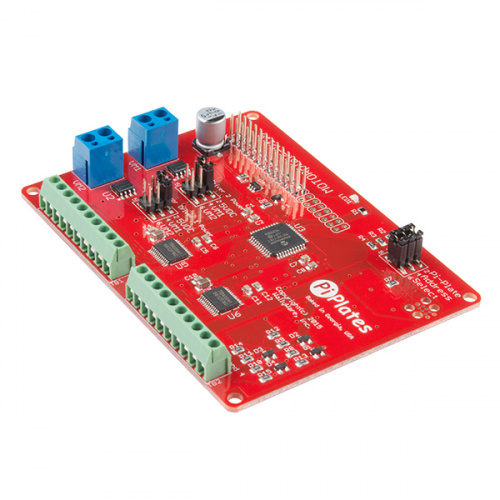Hello there, and happy Friday! In anticipation of Pi Day next Tuesday, we decided to show off these amazing add-on boards: Pi-Plates! We have three new "plates" to show you, each with its own unique function and importance to make your Raspberry Pi even more amazing! Without further ado, let's jump to see what Feldi has for us this week.
Serving up a fresh helping!
The DAQCplate (Data Acquisition and Controller) from Pi-Plates adds a rich set of input/output options to your Raspberry Pi. It includes seven powerful digital outputs for driving external devices such as relays and high-current LEDs, as well as eight analog-to-digital inputs for measuring temperature, voltage, humidity and more. Additionally, there are eight digital inputs, two analog outputs and seven general-purpose indicator LEDs.
Second up, the MOTORplate brings a suite of professional motion control features to your Raspberry Pi. These plates can each control a combination of two stepper motors, four DC motors or one stepper and two DC motors. An onboard microprocessor does all the hard work, including controlling acceleration trajectories and microstepping. By offloading these functions, your Raspberry Pi is free to perform other tasks. Use this board to control a precision XY stage driven by stepper motors. Or, drive the treads of your killer robot.
Last up today, we have the RELAYplate. This plate is the first dedicated relay board for the Raspberry Pi, designed to meet the safety requirements of UL 60950 while being capable of switching 120 volts AC. Each of the seven relays is UL rated to switch 1 amp at 120 volts AC or 30 volts DC. And, like all Pi-Plates, you can stack these boards to increase your relay count to 56 using eight plates. The RELAYplate board is compatible with the DAQCplate and MOTORplate, allowing you to create the perfect stack of boards to control your project.
That's it for this week, folks. Be sure to check back this coming Tuesday (March 14) to see what we have in store for Pi Day. We'll be back next Friday with another slew of new products for you! See you then.










The issue with HATs and Plates is that you really need to release or partner with someone to release cases that work with the baseboard and add-on boards. This seems to be missing across the entire maker community. Even though 3D printers are readily available, but users are not CAD experts.
So, why is there a new term invented for these? Why are they not called "hats"? (Arduino has "Shields", Beagle Bones have "Capes", and RPis have "Hats"...) So when someone mentions they are using a Hat, one can deduce they are basing their project on an RPi or compatible.
Or is it these don't have the EEPROM identifier chip that proper Hats should have?
I suspect the reason is the manufacturer was hunting for a unique trademark for their product line.
This is not a new term - we came up with it about 3 years ago while trying to think of a product name that would associate the RPi to a family of stacking boards. Thus the names "Pi-Plates." I believe Adafruit came up with it before we did.
HATS came after we had already designed a few boards. And while they're nice and tidy, they don't lend themselves to stacking very well. In addition, the EEPROM identification strategy is too simplistic for our needs.
For a more detailed examination of our opinion of HATS, see our blog posting "The Problem with HATS" at http://pi-plates.com/the-problem-with-hats/
I suspect the main reason these are not called HATs is the form factor - they are quite a bit larger than a standard HAT.